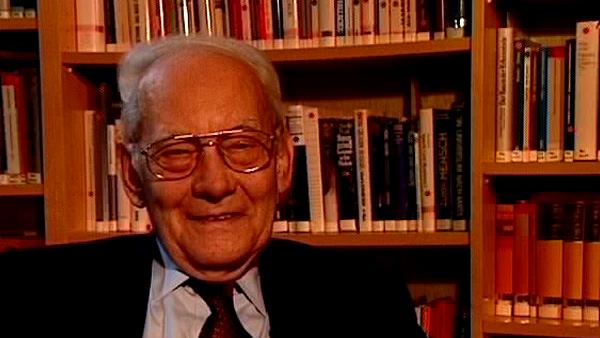NEXT STORY

Manfred Eigen and Ruthild Winkler's book The Laws of the Game
RELATED STORIES

NEXT STORY

Manfred Eigen and Ruthild Winkler's book The Laws of the Game
RELATED STORIES


|
Views | Duration | |
|---|---|---|---|
| 91. The versatility of viruses | 1 | 52 | 02:07 |
| 92. Polio: acceptance of errors | 47 | 02:13 | |
| 93. Virus detection methods | 43 | 03:56 | |
| 94. Prions are protein molecules not viruses | 54 | 02:14 | |
| 95. Autocatalytic proteins in BSE | 51 | 06:07 | |
| 96. Methods for early detection of prion diseases | 39 | 03:47 | |
| 97. Manfred Eigen and Ruthild Winkler's book The Laws of the... | 265 | 04:23 | |
| 98. The difference between chemical reactions and living systems | 82 | 03:32 | |
| 99. Why do we do research? | 69 | 02:18 | |
| 100. Talent | 135 | 00:43 |


Your question: can we do something with our method in the case of prion diseases, would have implications also on Alzheimer, and we are at the moment interested in an early diagnosis. Now I said before that the disease cannot be triggered by single units, that came out of our paper. You need a co-operative, like in an allosteric enzyme, you need several subunits, or even a formation of little crystallites, so that you have a supersaturated solution and the infectious unit triggers that process of transformation. Well in both cases, what has been shown for the BSE is that you get plaque formation, very similar as in Alzheimer's disease. In other words there are decomposites of the protein in form of plaques which you can see under the microscope, and the co-operativity might well be connected with it. Be it as it may, it would yield us a very nice way of diagnosis, of early diagnosis, and that again is based on fluorescence correlation spectroscopy. But now we don't use the auto-correlation, we rather use cross-correlation and I must explain what I mean by that.
If you have a aggregate being the cause of the disease, then it means that several molecules have to get together, and when you can show that the infectious one does such a thing, then by proving the existence of these complexes you can very early diagnose the disease. And what we now do is we take two fluorescence dyes, and put one on part of the molecules and the other one on another part of the molecules, the non-infectious ones. Now in a case of non-infection these molecules remain separate and we see either the blue or the red fluorescence or the green fluorescence, but we see them separately. And what we do now is cross-correlation, that means we... you remember when I explained auto-correlation is that we measure products of intensities, an intensity at a given time, T, times the intensity at a moment afterwards, a T plus the other T. Now here we also measure products of intensity but not on time-scale. We now take intensity at a time T of the green fluorescence times the intensity at time T of the red. Now if they are separate, the molecules, these are independent quantities, and the product would be zero, apart from noise. But if they form a complex they fluoresce at the same time and then the product would be finite, and this method is very, very sensitive. And this is always in a disease an important point to see it as early as possible and then start with some anti-viral strategy or anti-disease strategy.
Nobel Prize winning German biophysical chemist, Manfred Eigen (1927-2019), was best known for his work on fast chemical reactions and his development of ways to accurately measure these reactions down to the nearest billionth of a second. He published over 100 papers with topics ranging from hydrogen bridges of nucleic acids to the storage of information in the central nervous system.
Title: Methods for early detection of prion diseases
Listeners: Ruthild Winkler-Oswatitch
Ruthild Winkler-Oswatitsch is the eldest daughter of the Austrian physicist Klaus Osatitsch, an internationally renowned expert in gas dynamics, and his wife Hedwig Oswatitsch-Klabinus. She was born in the German university town of Göttingen where her father worked at the Kaiser Wilhelm Institute of Aerodynamics under Ludwig Prandtl. After World War II she was educated in Stockholm, Sweden, where her father was then a research scientist and lecturer at the Royal Institute of Technology.
In 1961 Ruthild Winkler-Oswatitsch enrolled in Chemistry at the Technical University of Vienna where she received her PhD in 1969 with a dissertation on "Fast complex reactions of alkali ions with biological membrane carriers". The experimental work for her thesis was carried out at the Max Planck Institute for Physical Chemistry in Göttingen under Manfred Eigen.
From 1971 to the present Ruthild Winkler-Oswatitsch has been working as a research scientist at the Max Planck Institute in Göttingen in the Department of Chemical Kinetics which is headed by Manfred Eigen. Her interest was first focused on an application of relaxation techniques to the study of fast biological reactions. Thereafter, she engaged in theoretical studies on molecular evolution and developed game models for representing the underlying chemical proceses. Together with Manfred Eigen she wrote the widely noted book, "Laws of the Game" (Alfred A. Knopf Inc. 1981 and Princeton University Press, 1993). Her more recent studies were concerned with comparative sequence analysis of nucleic acids in order to find out the age of the genetic code and the time course of the early evolution of life. For the last decade she has been successfully establishing industrial applications in the field of evolutionary biotechnology.
Tags: prion diseases, Alzheimer's disease, BSE, Bovine spongiform encephalopathy, allosteric enzyme, crystallites, fluorescence correlation spectroscopy
Duration: 3 minutes, 48 seconds
Date story recorded: July 1997
Date story went live: 29 September 2010